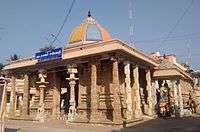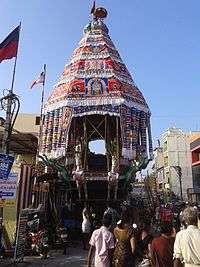Nageswaraswamy Temple, Kumbakonam
| Nageswaran Temple | |
|---|---|
 | |
 Nageswaran Temple Location in Tamil Nadu | |
| Name | |
| Other names | Kudanthai Keezhakottam |
| Geography | |
| Coordinates | 10°59′0″N 79°23′0″E / 10.98333°N 79.38333°ECoordinates: 10°59′0″N 79°23′0″E / 10.98333°N 79.38333°E |
| Country | India |
| State | Tamil Nadu |
| District | Tanjore |
| Location | Kumbakonam |
| Culture | |
| Primary deity | Nageswaran(Shiva) |
| Temple tank | Surya Theertham |
| Appeared for | Vanni |
| Architecture | |
| Architectural styles | Dravidian architecture |
Nageswaran Temple is a Hindu temple dedicated to Lord Shiva located in Kumbakonam, Tamil Nadu, India.[1] The temple is incarnated by the hymns of Thevaram and is classified as Paadal Petra Sthalam. Shiva in the guise of Nagaraja, the serpent king and is located in the centre of Kumbakonam.
History

Aditya Chola constructed this temple during the 9th century. It is great marvel of Chola architecture, building technology and astronomy. The orientation is structured in such a way that it allows sunlight inside the temple, right on the sanctum only during the Tamil month of Chithirai (April/May). It bears another name called Surya Kottam or Keezha Kottam. The Karuvarai (Sanctum Sanctorum) of Nageswaran temple is similar to Sarangapani Temple, as it is made in the form of a Chariot. The temple consists of three gopurams in the eastern, western and southern directions.
There is a local belief that the worship during morning, afternoon and evening needs to be performed at the three Nageswaran temples namely Nageswaran Temple, Tirunageswaram and Thirupampuram respectively.[2] The temple is designed in such a way that during the first three days of Tamil month Chittirai (April - May), the rays of the Sun falls directly in the base of the presiding deity in sanctum sanctorum.[3]
Legend
This vast temple known is for its shrine of Rahu, one of the nine celestial bodies in the Navagrahas. A legend has it that the mythological serpents Adiseshan, Dakshan and Kaarkotakan worshipped Lord Shiva here. Legend also has it that King Nala worshipped Shiva here as in Thirunallar. There is a Naganathar temple at Tirunageswaram having similar features like temple. This place has been referred in Tevaram written by Saint Tamil poet of 7th Century AD, Thirugnana Sambanthar.[4]
Architecture

The temple shows early Chola art in its best form particularly in the form of human figures. The sanctum is of padabandha-padmaka type stands on padmopana. The lotus leaves of the padmopano are carved with vitality. In its iconographic scheme the Ardhanari, Brahma and Dakshinamoorthy in the niches of the outer wall are featured. The other sculptures on the walls almost life-size reflect either the donors to the temples or contemporary princesses and princes. The epic scenes are in low relief on the plinth below the pilasters of the walls of the sanctum, recalling the wood work.
The Devi shrine is an independent structure situated in the outer prakaram(outer precincts of a temple), detached from the axial unit, though it faces south, a feature common to Saiva Devin shrines. The complex of Nataraja shrine is in the form of a chariot on wheel drawn by horses as in the case of Airavatesvara Temple at Darasuram and Sarangapani Temple in Kumbakonam.[5]
Gangai Vinayagar

During Rajendra Chola's Ganges expedition, the victorious chola army brought a beautiful Vinayagar statue as a war trophy to the chola empire. The Vinayagar statue was kept at this temple and was aptly named as Gangai Vinayagar. Currently, the Vinayagar is present in the ardha mandapam, in front of the sanctum of Nageswarar. The Vinayagar seems to be in the Pala style.
Specialty
12 Shiva temples are connected with Mahamaham festival which happens once in 12 years in Kumbakonam. They are :
- Kasi Viswanathar Temple,
- Kumbeswarar Temple,
- Someswarar Temple,
- Nageswara Temple,
- Kahahasteeswarar Temple,
- Gowthameswarar Temple,
- Koteeswarar Temple,
- Amirthakalasanathar Temple,
- Banapuriswarar Temple,
- Abimukeswarar Temple,
- Kambatta Visvanathar Temple and
- Ekambareswarar Temple.
This temple is one among them.[6]
Notes
- ↑ Census of India, 1961, Volume 7; Volume 9
- ↑ Sharma, Sridhara (2007). Kumbakonam Azhaikkirathu. New Horizon Media. pp. 20–23. ISBN 9788183682244.
- ↑ R. 2001, pp. 217-8
- ↑ "campantar tEvAram -2" (PDF). projectmadurai.org. Retrieved 16 July 2011.
- ↑ Temples of South India P.112. V.V. Subba Reddy
- ↑ Mahamaham Festival 2004 (in Tamil), Hindu Religious and Charitable Endowments Administration Department, Government of Tamil Nadu, 2004
References
- Ayyar, P. V. Jagadisa (1991). South Indian shrines: illustrated. New Delhi: Asian Educational Services. ISBN 81-206-0151-3..
- R., Dr. Vijayalakshmy (2001). An introduction to religion and Philosophy - Tévarám and Tivviyappirapantam (1st ed.). Chennai: International Institute of Tamil Studies.
External links
| Wikimedia Commons has media related to Nageswaran Temple. |

